Last updated on March 22, 2024

Ayula, Queen Among Bears | Illustration by Jesper Ejsing
As you probably know being a reader of ours and most likely a frequent Limited player, 17 is the industry standard for lands played in 40-card formats. But why is this, and when should you play more or less than 17 lands?
Let's talk about that.
The Basics of Lands in Limited
For starters, the default number of 17 lands is a function of the average Limited deck’s mana curve. Let’s demonstrate this by taking a look at a fairly average Sealed deck I recently played that had 17 lands:
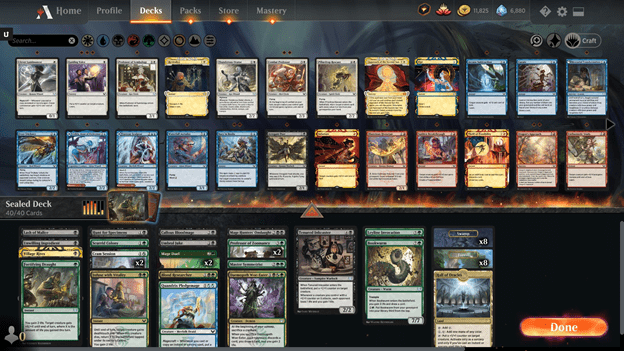
Why is this deck playing 17 lands rather than, say, 16 lands (-1 Forest, +1 Arrogant Poet) or 18 lands (-1 Tenured Inkcaster, +1 Swamp)? The easy answer is a mix of math and opportunity cost.
Thanks to the always useful work of Frank Karsten, I have a handy chart showing the differences between the number of lands and the odds of hitting each early land drop, plus the odds of mana flood:
| Lands in Deck | P(2 lands by turn 2) | P(3 lands by turn 3) | P(4 lands by turn 4) | P(5 lands by turn 5) | Exp. opening hand | P(mana flood) |
|---|---|---|---|---|---|---|
| 17 | 96.8% / 95.6% | 77.2% / 69.1% | 51.1% / 41.0% | 28.8% / 20.8% | 6.458 cards | 1.2% |
| 18 | 97.7% / 96.8% | 80.7% / 73.0% | 56.3% / 45.9% | 33.8% / 24.9% | 6.530 cards | 1.9% |
| 19 | 98.4% / 97.7% | 83.8% / 76.5% | 61.2% / 50.6% | 39.0% / 29.2% | 6.594 cards | 2.8% |
| 20 | 98.9% / 98.3% | 86.4% / 79.6% | 65.8% / 55.2% | 44.1% / 33.7% | 6.649 cards | 3.9% |
| 21 | 99.2% / 98.8% | 88.6% / 82.3% | 70.0% / 59.6% | 49.3% / 38.3% | 6.697 cards | 5.4% |
| 22 | 99.5% / 99.2% | 90.5% / 84.7% | 73.9% / 63.7% | 54.3% / 43.0% | 6.738 cards | 7.3% |
| 23 | 99.6% / 99.4% | 92.1% / 86.8% | 77.4% / 67.7% | 59.1% / 47.6% | 6.772 cards | 9.5% |
| 24 | 99.8% / 99.6% | 93.5% / 88.7% | 80.6% / 71.3% | 63.8% / 52.2% | 6.801 cards | 12.2% |
| 25 | 99.8% / 99.7% | 94.6% / 90.4% | 83.5% / 74.7% | 68.2% / 56.7% | 6.825 cards | 15.2% |
| 26 | 99.9% / 99.8% | 95.6% / 91.8% | 86.0% / 77.9% | 72.3% / 61.1% | 6.844 cards | 18.7% |
| 27 | 99.9% / 99.8% | 96.4% / 93.1% | 88.3% / 80.8% | 76.0% / 65.3% | 6.858 cards | 22.6% |
| 28 | 99.9% / 99.9% | 97.1% / 94.2% | 90.2% / 83.4% | 79.5% / 69.2% | 6.868 cards | 26.8% |
The numbers for 17 lands in Limited are similar to the ones for 25 lands in Standard. This also makes sense because 25 * 40/60 = 17.5. Since typical Limited decks need their first 3 land drops, would like to hit their 4th land drop, but don’t necessarily need 5 lands by turn 5, the age-old standard of 17 lands indeed seems like a good number.
Frank Karsten
The above deck matches this up very well. Hitting the first four land drops is essential, but being stuck at four for a bit with a Tenured Inkcaster/Bookwurm/etc. in hand wouldn’t be likely to sink me too hard, as 20 to 23 of my spells cost less than five mana.
So which decks should play 16 lands, then? 18 lands? Or perhaps even more or less than that? Let’s get into it.
16 Lands
16 lands is the energetic, less uptight (though perhaps a little less reliable) little brother of 17 lands, and probably the second most common number of lands to play in Limited. When should you play 16 lands over 17? A few reasons:
- Your deck’s mana curve is a bit lower than the average 17-land deck with only a few cards costing more than three mana.
- You have several cheap spells to help find lands if needed.
- You’re not splashing any cards.
- Your deck only has a few mana sinks, none of which are particularly amazing.
- You’re playing BO1 on Arena.
- You’re on the draw (more on this later).

Let me offer you two examples of 16-land decks.
Orzhov Aggro
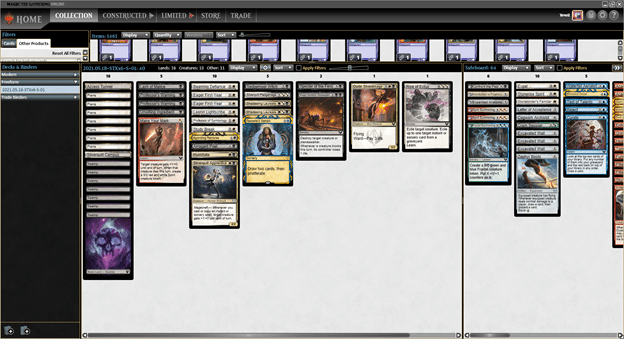
This is a Sealed deck that I went 3-1 with in a Limited PPTQ. It’s a very aggressive Orzhov deck (particularly for Sealed) with a low curve (mostly 2s, some 1s and 3s, only four cards that cost above three mana). My decision to play 16 lands was a bit of a no brainer, though I might’ve played 17 lands with Access Tunnel as a bit of a compromise as the 17th land with a higher curve.
My curve was low enough that I could’ve even considered 15 lands (more on that later), but I didn’t because I wanted to play Access Tunnel and at least eight sources of white and black mana (Campus Guide plus seven Plains and seven Swamps).
Moldering Karok Wins Out
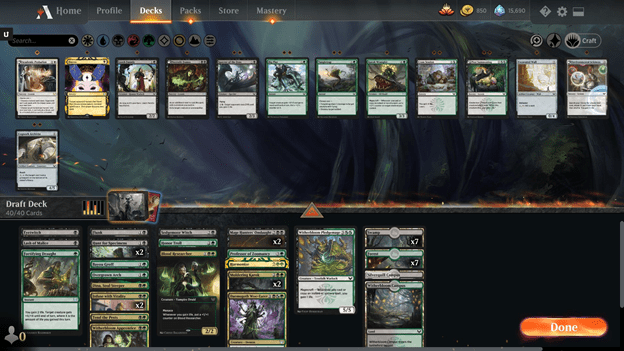
This deck, on the other hand, is a BO1 draft deck I 7-0’d with on MTG Arena Premier Draft. Unlike the Orzhov deck, this is a more midrange-y deck with a higher curve featuring seven 4-drops. Bayou Groff is probably more of a 5-drop than a 2-drop here, so my curve is a tiny bit higher than it looks, too. So why not play 17 lands, then?
That was certainly my first instinct, but I ended up choosing to play 16 because I thought the second Moldering Karok (my 24th card) was worth more here than another land. I also had two Hunt for Specimens which could reliably pick up my Environmental Sciences if needed.
This deck also has a fairly low curve, with only two 5-drops, no 6-drops, and a synergistic game plan that isn’t especially well-equipped to handle massive mana flood. My only major mana sinks late game are the two Campus Guides. Lastly, I was playing BO1 on Arena, which employs a hand smoothing algorithm that artificially favors decks with lower land counts than normal.
18 Lands
So if 16 lands is the “energetic little brother” of 17 lands, I guess that makes 18 lands the stoic, always reliable eldest of the trio? Weird family metaphors aside, when should you play 18 lands over 17?
- Your deck has a high mana curve/strong late game.
- Your deck can’t function if it misses its fourth land drop.
- You have several effective mana sinks in case you flood out.
- You’re splashing two off-color basics.
- You’re playing a slow format and don’t expect to get ran over.
Let’s take a look at a couple 18-land decks to get us started.
4-Color Greedy Power
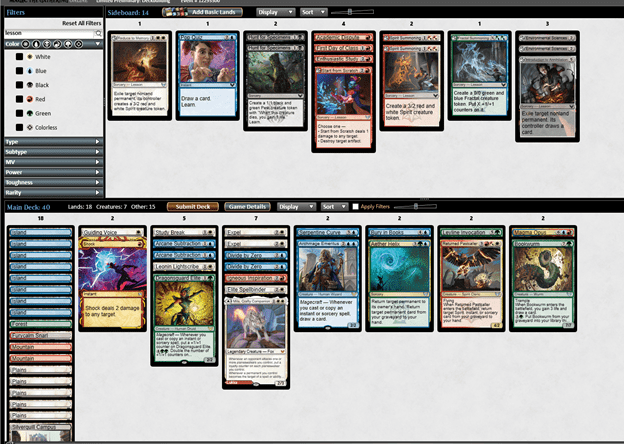
This is AlphaFrog’s Sealed deck from another Limited PPTQ. He put together a greedy but powerful four-color deck. It has a lot of top end (four 6+-drops not including the backside of Mila, Crafty Companion), lots of card advantage, and several splashes that heavily lean on the seven learn cards plus Environmental Sciences to tie together. The learn cards can also grab Fractal Summoning in case he floods out, so having extra lands isn’t particularly concerning.
The Biblioplex Saves the Deck

Here’s another Sealed deck (also from AlphaFrog) to demonstrate a different take on 18 lands. In this case, the decision to play 18 lands is unorthodox, given the mana curve which looks optimal for 17 lands at first glance.
The key cards that were responsible for this were the two The Biblioplexes. It’s a colorless land that doubles as a solid late game mana sink, providing card advantage (or at minimum, card selection) once you’ve emptied your hand. But it doesn’t contribute to the mana base in the same way that another Forest or Swamp would as a colorless land.
Rather than leave one The Biblioplex in the sideboard, simply play both and cut a spell for the second one. There are eight black sources, seven green sources, two blue sources plus Cultivate, and two The Biblioplexes for a consistent late game mana sink. Most 18-land decks won’t look like this, but it’s worth highlighting these rare cases where 18 lands is about maximizing spell lands.
It’s also worth mentioning that some would-be 18-land decks might just be better as 17-land decks. Cards like Field Trip, Cultivate, Letter of Acceptance, and similar cards from non-Strixhaven sets do a good job at providing extra mana if you need it. Does your Temur deck with two Curates, a Campus Guide, two Field Trips, and Cultivate really need an 18th land over another spell? That’s for you to decide.
19 Lands
18 lands not enough for you? Want to make sure you’re over 80% sure to hit your fifth land drop on time? Then you’re on the right track with 19 lands. Some reasons to consider the 19th land:
- Exceptionally high mana curve with few if no 2-drops and several expensive late game bombs.
- Serious payoffs for hitting land drops including but not limited to: excellent mana sinks, landfall triggers, morph activations, etc.
- Few if any compelling playables remaining in your pool, none of which seem worth more to you than a 19th land.
Evolving Wilds FTW
Creatures (11)
Zof Shade x2
Indulgent Tormentor
Stormtide Leviathan
Jorubai Murk Lurker x2
Gravedigger
Necromancer's Assistant
Gargoyle Sentinel
Witch's Familiar
Wall of Frost
Instants (5)
Lightning Strike
Negate
Dissipate
Unmake the Graves
Flesh to Dust
Sorceries (4)
Festergloom
Divination
Covenant of Blood
Sign in Blood
Enchantment (1)
Lands (19)
Evolving Wilds x3
Mountain
Island x7
Swamp x8
As Reid Duke himself describes here in greater detail, this was an unusual decision that he attributed to his high mana curve, several mana sinks, solid density of card advantage, and light red splash. An unnoted factor that works slightly in favor of a higher land count here is the three Evolving Wilds.
Though I’d caution you against overrating the value of “deck thinning,” it’s not irrelevant that drawing and using the Wilds removes a land from your deck. This reduces the odds of you drawing another land next turn by roughly 2.5%. This isn’t a massive difference, but it’s also not irrelevant given that we’re devoting several paragraphs to the differences between playing one piece of cardboard over another.
MDFC Trickery

One last example of a 19-land Limited deck is this top 8 draft deck from Jaberwocki. Zendikar Rising was a bit of a cheater in terms of land counts, as it was the only Limited set to date that featured land/spell modal double-faced cards.
Jaberwocki is playing “19 lands” (16+3 MDFCs), “16 lands,” or maybe some number in between that, depending on your interpretation. I played decks with anywhere from 16 to 22 lands in ZNR, though these “22-land” decks were obviously playing at least five MDFCs. 18 to 20 lands was my most commonly played configuration in that very unusual format.
Zendikar Rising aside, I generally wouldn’t recommend playing 19 lands in most Limited decks. Most greedy/controlling Limited decks will do fine with 18. Even very controlling 18-land decks can just be 18 lands plus several cards that draw or fetch lands for you (Cultivate, Field Trip, Pop Quiz with access to Environmental Sciences, etc.) and skip the 19th land.
Still, Reid Duke did win GP Portland in 2014 playing 19 lands, so I wouldn’t discount the option entirely!
Less Than 15 Lands
We’ve just covered the “high life” of Limited deckbuilding, but what about all the low lives out there who just want to play 1-drops, 2-drops, and pump spells? Don’t they get a section?
Why yes, they do! One section, in fact, to cleanly wrap things up. So, what are some reasons to play 15 or fewer lands? Let’s take a look:
- You’ve built a hyper aggressive, possibly mono-colored deck with a very low mana curve and very little late game/mana sinks.
- The format you’re playing has a unique architecture like cycling from Ikoria or MDFCs in Zendikar Rising that rewards you for skimping on traditional land counts.
- You have a dual land or two to hit 8/8 color minimums while also having the kind of mana curve that would want 15 lands in the first place.
As always, the wonderful Frank Karsten has written an excellent piece examining the potential of very land-light Limited decks in great detail. One particularly damning thing to note is this chart:
| Number of sources of a color | Probability of having at least one source in your top 9 cards | Probability of having at least two sources in your top 10 cards |
|---|---|---|
| 7 | 85.9% | 57.2% |
| 8 | 89.7% | 65.9% |
| 9 | 92.6% | 73.4% |
| 10 | 94.8% | 79.6% |
This table shows that with 7 Swamp and 7 Plains, you will have the required Plains to cast a turn-3 Territorial Hammerskull only 85.9% of the time (on the play, in absence of mulligans or card selection). So 14.1% of the time, you’re color-screwed.
Frank Karsten
I’ve mentioned eight minimum sources of each primary color, but these numbers should clearly show you why skimping on this is usually a bad idea! And without any dual lands or additional mana fixing, a 16-land deck with an 8/8 split of basics is just barely hitting both minimums.
You can’t really expect your 14-land, seven Plains plus seven Mountains Boros deck to have consistently good aggro openers… or can you? Well, there are two possibilities to consider, both of which reference relatively recent developments in Magic.
Amonkhet and Ikoria
The first nod in favor of possibly playing 15 or fewer lands is if you’re playing Amonkhet or Ikoria draft. Both of these formats featured cycling as a primary mechanic, which was heavily featured in each color.
Ikoria actually took this a step further by having cycling on so many different commons, meaning that decks focused on the cycling mechanic could play lots of cards that were effectively just blank cyclers. With so many cheap spells available, Ikoria allowed deckbuilders to reach levels of greed previously thought impossible.
One Mana, Draw a Card
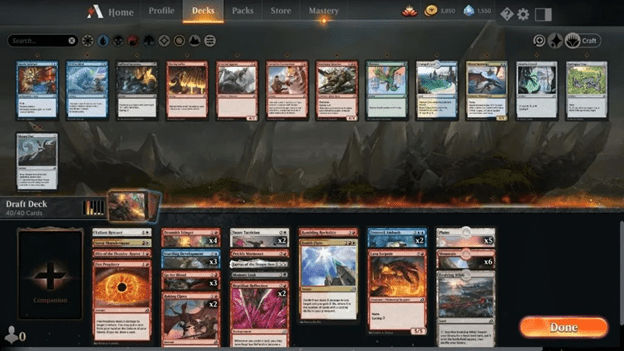
Yes, that is just 12 lands being played here, courtesy of this deck having 13 cards that say, “one mana, draw a card” and four cards that do the same for two mana. Week 1 Ikoria frequently had players on 14 to 15 lands, but this eventually gave way to the 12-land minimum you see here. 14 lands was actually on the higher end of the format, at least for Boros cycling decks.
The second nod in favor of playing 15 or less lands is the aforementioned BO1 algorithm which I touched on briefly in the 16-land decks bit. This 12-land deck not only has 17 cyclers, but it also has the BO1 algorithm working for it behind the scenes to help its player have more fun by subtly rigging their opening hand/subsequent draws. I wouldn’t push this point too hard in non-Ikoria formats, but I might consider 14 or 15 over 16-lands occasionally, particularly in something like mono-red aggro where I wouldn’t have to worry about hitting 8/8 color minimums.
20+ Lands
Wait, you're serious? You actually want half or more of your Limited deck to be lands? And you aren’t even playing Zendikar Rising?
I personally can’t recall ever seeing a 20- or 21-land draft deck. This is because those decks would likely be playing 17 or 19 lands plus spells/mana ramp/etc. to help hit extra land drops as needed. I have, however, seen meme decks playing 36+ lands. This sounds insane at first but can basically be attributed to certain Limited formats having strange rares that greatly reward playing absurd amounts of land.
Ayula, Queen Among Bears
Here’s an example list from a Modern Horizons draft a friend of mine (Slatorade) did:

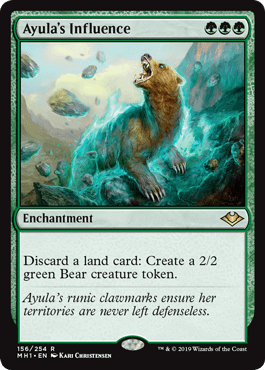

The only spells in this pile of 36 Forests are Ayula's Influence (all lands can be instant, 0-mana 2/2 bears), Ayula, Queen Among Bears herself (2/2 for one green that rewards you for putting bears into play), and two Winding Ways which would almost always draw four Forests.
Slatorade’s plan is to aggressively mulligan into Ayula's Influence and then hope the endless stream of bears (with an explosive turn 3) can get the job done!
Lost in the Woods

A similar gimmick could be employed in Dark Ascension Limited thanks to this memorable piece of draft trash. With a deck of 39 Forests and one Lost in the Woods, you could employ a formidable cheese strategy.
Basically just aggressively mulligan into a Lost in the Woods and slam it on turn 5. Because your deck is 100% certified green energy, your opponent can’t hope to defeat you with combat damage and instead must turn to mill, direct damage, enchantment removal, or other fiendish tricks. And since you likely mulled to at least five cards if not lower, as a mull to two in this deck is basically the same as keeping 7 cards, you should be behind your opponent in the decking game too. If they can’t come up with some creative way to kill you or remove your win condition, well, they might just find themselves losing in the woods.
Mana Screw and Flood
A common rookie mistake with mana bases is to react to one unfortunate game of drawing too few or too many lands by adding/taking a land out. This is generally a bad idea as you should be building your game 1 mana base with your optimal curve/color distribution in mind, which doesn’t change just because you’ve suffered a bad bout of variance.
The notable exception to this rule is the concept of a “16.5” land deck. This is a deck that plays 17 lands (and may have been close to starting 16 lands) but chooses to board out a land for a 24th spell whenever it’s on the draw. This makes sense because of the card dynamics of play/draw; the player going first has a default tempo lead, but the player on the draw is up a card, which increases their odds of hitting land drops on curve a bit. This technique is a way to optimize the land/spell ratio for decks that are very close between 16 and 17 lands.
When to Sideboard a Land In or Out
You could try boarding out a land on the draw in all sorts of decks, including 18- and 19-land decks. You’d make this decision with the assumption that you’ll be playing a very long game and that you can afford to stall on hitting land drops a bit more without fear of getting run over.
In this case you’re trading a bit of consistency for extra power level. You’re concerned about spell density in a hypothetical very long game of Magic. As logical and likely tempting as this may sound, be careful doing this, particularly if you have to jeopardize vital colored mana sources.
And finally, how about the reverse: should you ever be boarding in more lands? The easiest “yes” would be if you’re adding a splash plus extra late game cards on the play, in which case an extra land might suit your new curve better than whatever you had. Another scenario worth considering would be in some kind of draw-go mirror, though this is extremely rare in Limited. The first player to start missing land drops in this match-up will usually find themselves at a severe disadvantage, so having more lands/ways to find land makes sense.
If you want to learn more about advanced tactics in sideboarding, I recommend checking out this course on Spikes Academy. They also have a course about limited that covers how to build great draft and sealed decks.
Wrap Up
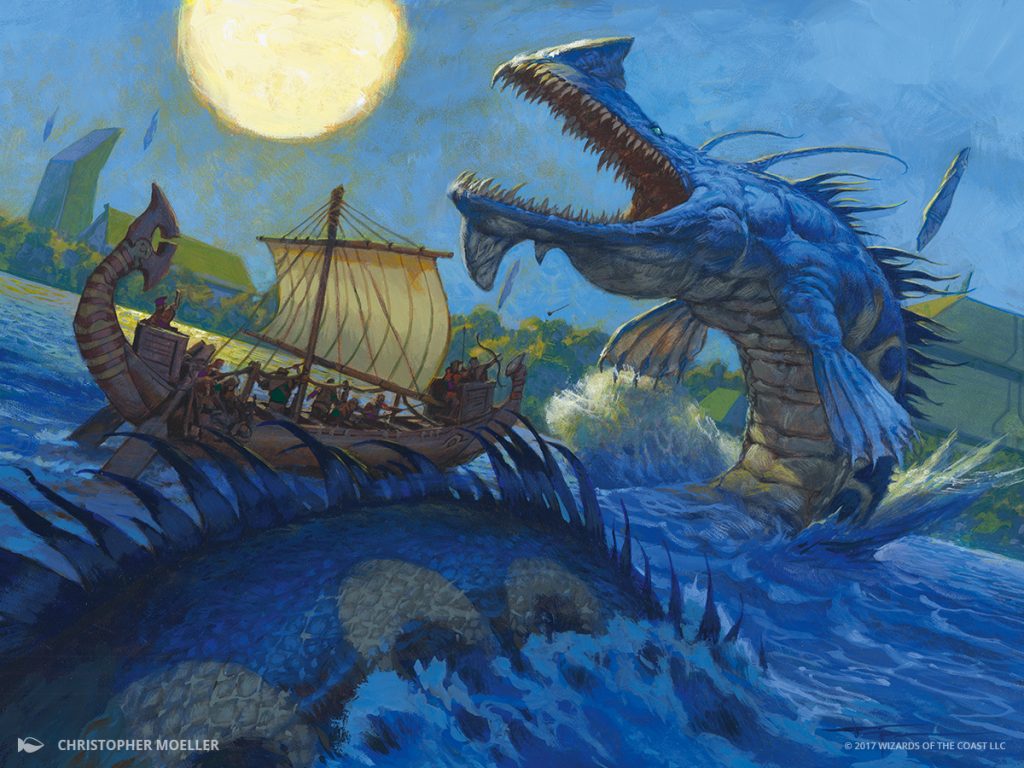
River Serpent | Illustration by Christopher Moeller
The best answer to how many lands you should play in Limited is actually “it depends,” not just “17.” Though 17 is certainly the second-best answer! You really can’t go too wrong with 17 lands, but I’d encourage you to at least try out 16 or 18 land configurations as well.
Strixhaven is a good format for testing different land configurations out. I’ve had success with 16-, 17-, and 18-land decks and have yet to play anything above or below those counts. And if you’re looking to draft on MTGA, make sure to check out Arena Tutor if you haven’t already.
Until next time, may you always draw the perfect number of lands each game!
Follow Draftsim for awesome articles and set updates: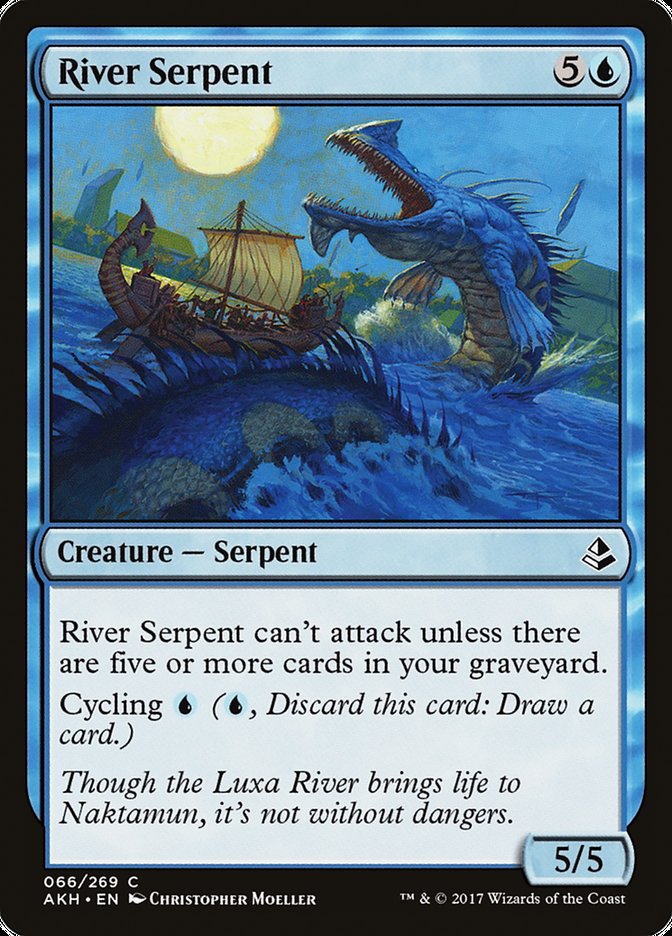
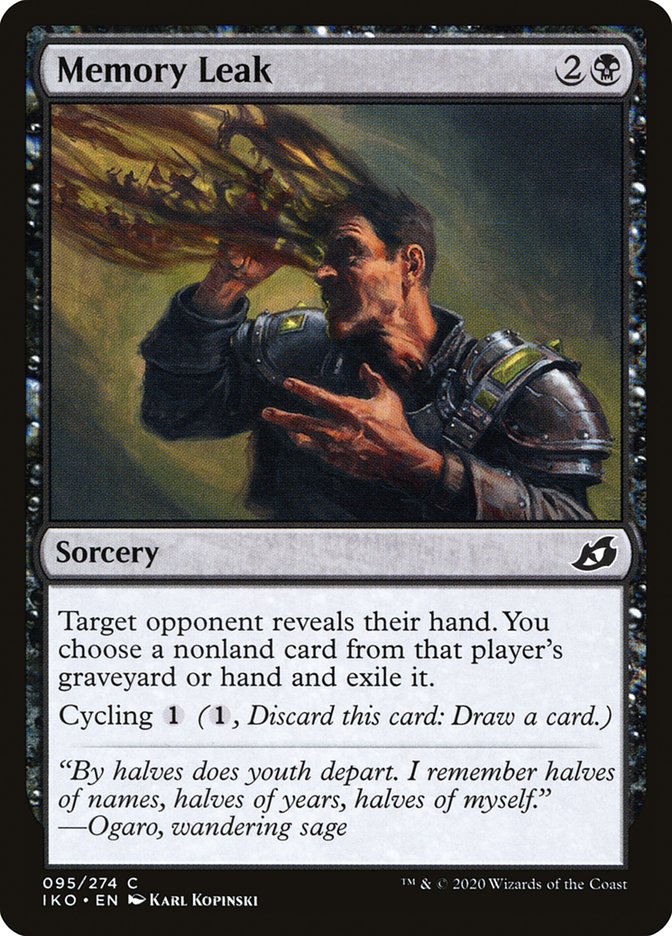


Add Comment